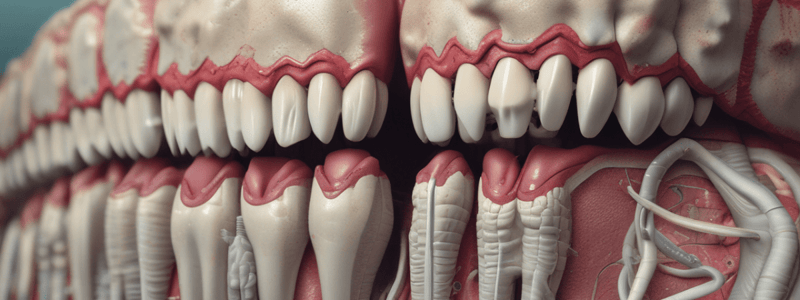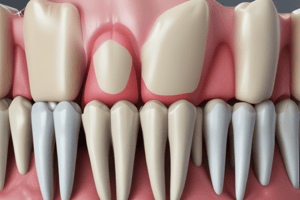Podcast
Questions and Answers
What is the main function of cementum?
What is the main function of cementum?
- To protect the dentin from wear and tear
- To provide attachment for the periodontal ligament (correct)
- To provide a smooth surface for the enamel
- To assist in the formation of the dental pulp
What is the composition of the inorganic substances in cementum?
What is the composition of the inorganic substances in cementum?
- Primarily enamel proteins
- Mostly calcium phosphate in the form of hydroxyapatite crystals (correct)
- Mostly collagen fibrils
- Predominantly polysaccharides
What is the relationship between cementum and Sharpey's fibers?
What is the relationship between cementum and Sharpey's fibers?
- Sharpey's fibers and cementum are separate structures with no connection
- Sharpey's fibers are responsible for the formation of cementum
- Sharpey's fibers are embedded within the cementum (correct)
- Cementum is a component of Sharpey's fibers
Which of the following statements about cementum is TRUE?
Which of the following statements about cementum is TRUE?
What is the significance of the high fluoride content in cementum?
What is the significance of the high fluoride content in cementum?
What is the main difference between cellular and acellular cementum?
What is the main difference between cellular and acellular cementum?
What is the primary organic component of cementum?
What is the primary organic component of cementum?
Where does cementum begin and end?
Where does cementum begin and end?
What is the primary role of cementoblasts in the structure of cementum?
What is the primary role of cementoblasts in the structure of cementum?
Where are cementocytes located within the cementum matrix?
Where are cementocytes located within the cementum matrix?
What feature characterizes resting cementoblasts?
What feature characterizes resting cementoblasts?
What type of cementum is typically found on the apical half of the root and contains cells?
What type of cementum is typically found on the apical half of the root and contains cells?
What distinguishes acellular cementum from cellular cementum?
What distinguishes acellular cementum from cellular cementum?
What are Salter lines in the context of cementum?
What are Salter lines in the context of cementum?
Which of the following types of fibers is present in intrinsic fibers cementum?
Which of the following types of fibers is present in intrinsic fibers cementum?
What is the characteristic feature of intermediate cementum?
What is the characteristic feature of intermediate cementum?
What is the primary feature of acellular cementum?
What is the primary feature of acellular cementum?
Which statement accurately describes mixed fibers cementum?
Which statement accurately describes mixed fibers cementum?
What occurs at the cementoenamel junction (CEJ) in most cases?
What occurs at the cementoenamel junction (CEJ) in most cases?
Which type of fibers primarily compose acellular cementum?
Which type of fibers primarily compose acellular cementum?
What characterizes cellular cementum compared to acellular cementum?
What characterizes cellular cementum compared to acellular cementum?
How does afibrillar cementum differ from other types of cementum?
How does afibrillar cementum differ from other types of cementum?
Which of the following statements about cellular cementum is true?
Which of the following statements about cellular cementum is true?
What is the result of the retraction of the reduced enamel epithelium?
What is the result of the retraction of the reduced enamel epithelium?
What stage do cementoblasts enter after reaching full thickness?
What stage do cementoblasts enter after reaching full thickness?
What is hypercementosis?
What is hypercementosis?
Cementum deposition at the apices of teeth compensates for which condition?
Cementum deposition at the apices of teeth compensates for which condition?
What term describes the fusion of cementum to alveolar bone with obliteration of the periodontal ligament?
What term describes the fusion of cementum to alveolar bone with obliteration of the periodontal ligament?
What do cementicles refer to?
What do cementicles refer to?
How does aging affect the permeability of cementum?
How does aging affect the permeability of cementum?
What is the role of cementum in the periodontal ligament?
What is the role of cementum in the periodontal ligament?
What is the primary function of fibroblasts during cementogenesis?
What is the primary function of fibroblasts during cementogenesis?
What is the primary type of cementum deposited on the enamel surface by mesenchymal cells?
What is the primary type of cementum deposited on the enamel surface by mesenchymal cells?
In what percentage of teeth does cementum meet the cervical end of enamel in a knife edge-to-edge pattern?
In what percentage of teeth does cementum meet the cervical end of enamel in a knife edge-to-edge pattern?
What can occur in approximately 10% of teeth where cementum does not meet enamel?
What can occur in approximately 10% of teeth where cementum does not meet enamel?
Which type of cells are responsible for cementogenesis?
Which type of cells are responsible for cementogenesis?
What is the process that involves both matrix formation and mineralization in cementum development?
What is the process that involves both matrix formation and mineralization in cementum development?
How does the mineralization process in cementogenesis occur?
How does the mineralization process in cementogenesis occur?
What characterizes the cementodentinal junction in deciduous teeth?
What characterizes the cementodentinal junction in deciduous teeth?
The arrangement of mineral crystals in relation to collagen fibers during cementum formation is:
The arrangement of mineral crystals in relation to collagen fibers during cementum formation is:
Flashcards are hidden until you start studying
Study Notes
Cementum
- Part of the periodontium, which is the investing and supporting attachment system of the teeth
- Consists of two soft tissues (gingiva and periodontal ligament) and two hard tissues (cementum and alveolar bone)
- A calcified, hard connective tissue derived from ectomesenchyme of the dental follicle, forming the outer covering of the anatomic root
- Begins at the cervical portion of the tooth at the cemento-enamel junction and continues to the apex
- Avascular and non-innervated
Physical Characteristics
- Color: Yellow, lighter than dentin but darker than enamel
- Hardness: Lesser than dentin
- Permeability: Permeable to inorganic ions and bacteria, which diminishes with age; cellular cementum is more permeable than acellular cementum
- Thickness: Thinnest at the cemento-enamel junction (20-50μm) and gradually thicker apically, ranging from 150-200μm or more
Chemical Composition
- 45-50% inorganic substances (calcium phosphate in the form of hydroxyapatite crystals)
- 50-55% organic substances (collagen fibers embedded in a ground substance, polysaccharides, and proteins)
- Contains the greatest amount of fluoride in mineralized tissues
Histological Structure of Cementum
- Two forms of collagen: collagen fibrils and collagen bundles
- Collagen fibrils constitute the main bulk of the organic material of cementum
- Collagen bundles represent the embedded portion of the principal fibers of the periodontal ligament, known as Sharpey's fibers
- Two types of cells functionally concerned with cementum: cementoblasts and cementocytes
- Cementoblasts line the root surface and contain numerous mitochondria and a well-developed Golgi complex; they become entrapped in the cementum matrix and form cementocytes
- Cementocytes are seen in lacunae in the cementum matrix and have numerous processes that may branch and anastomose with those of adjacent cementocytes
Types of Cementum
- Based on cellular content:
- Cellular cementum: contains cells called cementocytes in lacunae, more frequently found on the apical half of the root
- Intermediate cementum: a thin, amorphous layer of hard tissue approximately 10 microns thick, intermediate between cementum and dentin
- Acellular cementum: doesn't contain cells, present on the cervical third or half of the root
- Based on fibrillar content:
- Intrinsic fibers cementum: fibers derived from the synthetic and secretory activity of cementoblasts
- Extrinsic fibers cementum: fibers originate from the principal fibers of the periodontal ligament (Sharpey's fibers)
- Mixed fibers cementum: contains both intrinsic and extrinsic fibers
- Afibrillar cementum: lacks fibers, formed when the reduced enamel epithelium retracts from the cervical region of enamel, allowing mesenchymal cells to invade and differentiate into cementoblasts
Cementoenamel Junction (CEJ)
- In approximately 60% of teeth, cementum overlaps the cervical end of enamel for a very narrow area at the CEJ
- In 30% of teeth, cementum meets the cervical end of enamel in a knife-edge-to-edge pattern
- In approximately 10% of teeth, cementum does not meet enamel, resulting in a zone of root dentin appearing devoid of cementum
Cementodentinal Junction
- The dentin surface upon which cementum is deposited is relatively smooth in permanent teeth
- The cementodentinal junction in deciduous teeth is sometimes scalloped
Cementogenesis
- Takes place in two phases: matrix formation and mineralization
- Three cell types responsible for cementogenesis: cementoblasts, cementocytes, and fibroblasts, all derived from ectomesenchymal cells
- Growth of cementum is a rhythmic process, with new cementoid formed and old one calcified
- Mineralization begins after forming the first layer of matrix, with mineral crystals deposited within and between collagen fibers
Clinical Considerations
- Hypercementosis: abnormal thickening of cementum, may occur in one tooth or all teeth, in local areas of one root or generalized to the whole root
- Cementum is more resistant to resorption from bone, making orthodontic therapy possible
- Fusion of cementum to alveolar bone with obliteration of the periodontal ligament is termed ankylosis
- Decrease in permeability of cementum with age
- Cementicles: calcified oval or round nodules found in the periodontal ligament, single or multiple, near the cemental surface
Functions of Cementum
- Furnishes a medium for the incorporation of the principal periodontal fibers, securing the binding of the tooth root to the alveolar bone
- Serves as a reparative tissue in case of root fracture or resorption
- Allows for functional adaptation of the tooth by cementum deposition at the apices, compensating for tooth loss occlusally by attrition
- Protects dentin by blocking the dentinal tubules
Studying That Suits You
Use AI to generate personalized quizzes and flashcards to suit your learning preferences.



